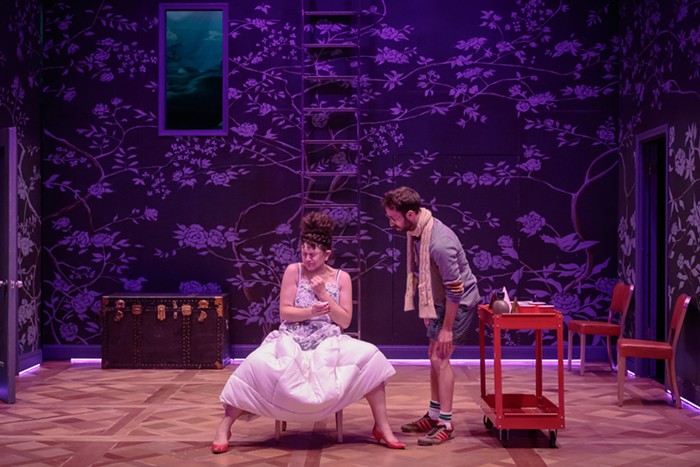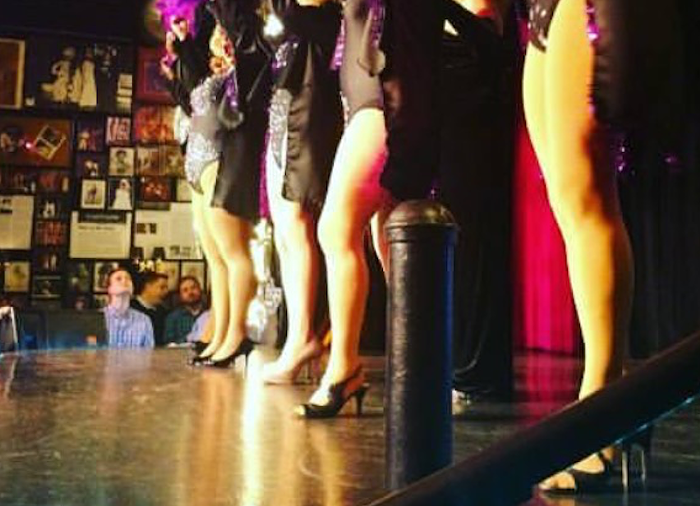New in Town
Portland Art Museum
1219 SW Park, 226-2811
Through June 23
The 13 artists included in the exhibit New in Town at the Portland Art Museum are certainly not new--in fact, each have garnered significant international attention for their respective work. However, this is the first opportunity for a Portland audience to view the work from the cast of art stars, who are all based out of Southern California. In general, the exhibit is painting-heavy and rooted in formalism, with allegiances noted to Pop Art and color-field painting. The most prominent theme however, is the simple issue of materials.
One common thread woven into the display is the "idea" of paint. Though paintings about paint are not a fresh consideration, there is one artist who tackles the notion in a new way. Linda Besemer accentuates the physical presence of paint in work that could also be described as sculptures. Essentially, Besemer manufactures sheets of acrylic paint and hangs them on aluminum rods. Through what must be a time-intensive process, Besemer builds up candy-colored, striped sheets of paint. The most vibrant example of this is "Zip Fold #7," a long, vertical work draped over an aluminum rod, with one end tacked to the wall. Besemer employs vivid colors--a bright grass green is married with stripes of orange, blue, and magenta. The taffy looking object appears to be stretched at points, which develops the idea of skin taken off the canvas. Formal aspects of the work really pop- the colors and the surface quality are massively appealing and what really nails the success of the piece is the polished and inviting, tactile presence.
Another artist captivated by paint is Michael Reafsnyder. However, his attempts are far less intriguing. His display of small panels only offer a haphazard accumulation of paint. For each piece, Reafsnyder must have plowed through dozens of tubes of oil paint, all for the sole reason of bulk. There appears to be no rhyme or reason to palette, as if he simply uses whatever colors were in the sale bin. The application of the paint is entirely uninspired--Reafsnyder simply squirts entire tubes of paint onto the panel, forming smiley faces and other "cute" imagery. Swaths of paint spread by a palette knife are the closest thing he provides to a gestural mark. The appropriately titled, "What the?" is the most egregious example of Reafsnyder's boorish intentions. A kamikaze palette and thick build up of paint does little to tease out an interest in notions of painting, but does cause one to consider a cake-frosting-job gone bad.
"New in Town" is touted as something relevant to the 21st Century--yet as many of the artists are mired in the rather tired and dated discussion of paint as material- interest is peaked only occasionally. One artist that contributes to the better portion of the exhibit is Chris Finley. His work "Drool Bird" is a welcome counterpart to the bevy of dry works in the exhibit. He offers a sort of melding of both formal issues; he pays attention to formal qualities by way of slick surface qualities and a pop culture references, but he includes something revolutionary--a provocative image. "Drool Bird" consists of a flat, Lichtenstein-esque background--a graphic interior space articulated by a blue wall and a darker blue floor. Occupying the space is a bird-monster hybrid that suffers from excessive drooling, a rendering strikingly similar to the work of Japanese painter Takashi Murakami. The creature presented is a cartoonish abstract beast, a sort of Puffin monster with extra eyes and saliva glands. The colors and shapes that form the Drool Bird are meaty and phallic, exceedingly sexual and aggressive. The image has an undeniable energy that seduces, and after a few minutes, turns viewers into a Drool Birds themselves.












